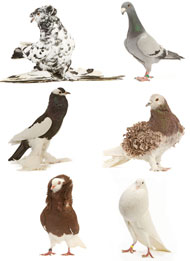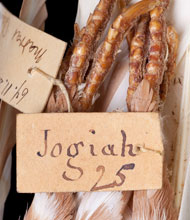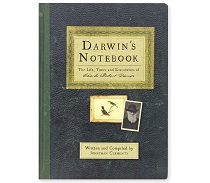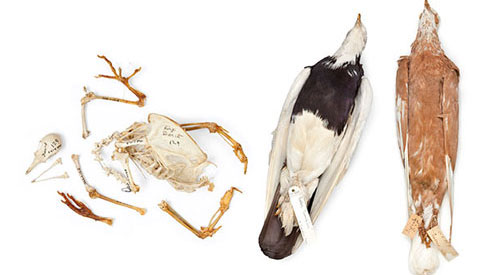Charles Darwin's pigeons
Charles Darwin bred pigeons. But as an experiment, not a hobby. By artificially selecting features, crossing birds with particular characteristics to generate different offspring, he gathered valuable evidence for his theory of evolution by natural selection. He gave all of his pigeon specimens to the Natural History Museum.

Fancy pigeon varieties, created by breeding birds with particular characteristics. Darwin used this process of artificial selection as an analogy for natural selection. © Jean Michel Labat / ardea.com
Artificial selection
Fancy pigeon breeders have created hundreds of varieties that look dramatically different to wild pigeons. Some have long legs, others very short beaks. Some have fan tails, others lots of feathers around their feet. But they all come from one species, Columbia livia.
Darwin was fascinated by how one species could be manipulated to such extremes. From his travels on HMS Beagle, Darwin suspected that the environment might naturally manipulate species, causing them to change over time, but he couldn't find a means to explore this effectively in the wild.
Experimenting with artificial selection in pigeons gave him a way to study how far a species could change.
The similarity between artificial selection and natural selection is at the heart of Darwin's explanation of evolution in his revolutionary book On the Origin of Species. And pigeons are the first creatures discussed in detail.
Preparing to shock the world
Even after 20 years of research, Darwin was worried about how his theory of how evolution worked would be received. It challenged the widely-held belief that God created the world. Not only that, but his beloved wife was deeply religious. He was also a shy man who preferred private study to public debates.
Darwin finally published On the Origin of Species in 1859. Earlier that year he wrote to William Tegetmeier, his main adviser on fancy pigeon breeding, telling him to expect a copy in the post as soon as it was published. That valuable first edition is also part of the Museum's collections.

Close-up of the original label on a pigeon specimen Charles Darwin gave to the Museum.
Insights into Darwin's research
After Darwin completed his breeding experiments, he gave all 120 of his pigeon specimens to the Museum. Some had been bred by him, others sent to him by fellow naturalists around the world.
Unlike the birds Darwin collected on his earlier Beagle voyage, most of these pigeons still have his original labels. Museum scientists are using them to link the specimens back to Darwin's original notes, revealing exciting insights into his research.
The Galapagos finches that Darwin collected on the Beagle voyage may be more famous, but these pigeons were more significant to his work.
Further information
- Visit some of Darwin's pigeon specimens in our new Treasures Cadogan Gallery.
- Watch a video about Darwin's mockingbirds, the birds that first pointed Darwin towards his ideas about evolution.
- Follow Darwin's 5-year voyage around the world on HMS Beagle.
- Find out more about Darwin's On the Origin of Species book.
Vote for your favourite treasure
Is this your favourite Museum treasure? Let us know by voting in our poll.
Listen to the Treasures podcast
Charles Darwin's pigeons story

Museum curator Jo Cooper, pigeon breeder John Elsdon and author of The Rough Guide to Evolution, Mark Pallen, discuss the birds that were so significant for Darwin’s revolutionary idea.
Listen to or download the Darwin's pigeons story 10min 13sec, 14.0MB
Toolbox

Buy Darwin's Notebook
Discover the wonder of Darwin. Featuring original drawings and notes from one of the world's most pioneering minds, this is an informative and enjoyable read.
Buy Darwin's Notebook: The Life, Times and Discoveries of Charles Darwin online
